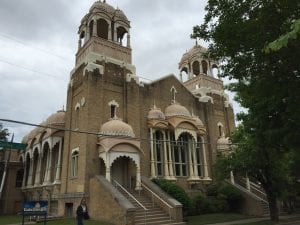The field trip I was looking forward to the most was the Hare Krishna temple visit. I would be immersed in a completely different culture and I would see many images from the Indian culture. The Dallas Hare Krishna temple was everything but lackluster.
When we arrived at the Hare Krishna temple, I was surprised by its facade. It was a little off putting, but at the same time fascinating seeing how an old church had been refashioned into a Hare Krishna temple, a religion entirely different than the religion previously practiced there. The inside was so amazingly different from its exterior that I instantly knew I had entered into an Indian establishment. Images of Krishna, Ganesha, and other deities greeted us as we became enveloped into the Hare Krishna temple. The emphasis that was put into the imagery in the temple really exemplified the extreme devotionalism practiced there. After taking our shoes off, we were able to enter the main room where most of the images and sculptures (like that of the wax figure of Prabhupada) were. This room was really something else. Every painting told a different story, and even further showed the devotion to Krishna.
It was obvious to see that the people who practice Hare Krishna have a very different attitude about life. As our tour guide, Prajapati, told us more about the Hare Krishna movement I learned how important it is for someone practicing Hare Krishna to be concerned with life after death, and realize that current life is temporary. It was odd to me to learn that the big Hare Krishna devotees are single to dedicate their life to the Hare Krishna movement. Much of the philosophy behind the Hare Krishna movement reminded me of Buddhist philosophy such as reaching peace knowing that the now is only temporary. This leads me to an aspect of the movement that bothered me a little.
At about half way into the tour, Prajapati mentioned that he believed that the movement was not “Indian.” Seeing all the images of Krishna, which literally come from India, and the fact that their iconic chant includes Rama and Krishna beg to differ, in my opinion. It was odd fro me to see a non-Indian person performing the offering to the gods, in what appears to be a very Indian temple. We had discussed in class prior the fine line between cultural dispersion and appropriation. I may have misunderstood what Prajapati meant by saying the movement was not Indian, but if I understood correctly, it seemed like a completely different culture had adopted Indian icons, deities, and teachings and changed them to create a new devotion. The only problem I have with this is the fact that it was denied that this was Indian. I believe credit should have been given there.
Aside from this, the Hare Krishna temple showed a mix of cultures, which is native to India being the cultural melting pot of the world. The Hare Krishna temple overall was most definitely interesting and eye-opening to the different kind of practices around the world.


